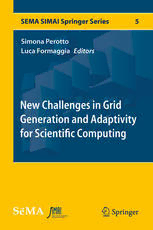
New Challenges in Grid Generation and Adaptivity for Scientific Computing PDF
Preview New Challenges in Grid Generation and Adaptivity for Scientific Computing
5 Simona Perotto Luca Formaggia Editors New Challenges in Grid Generation and Adaptivity for Scientific Computing SeMA SEMA SIMAI Springer Series SeriesEditors:LucaFormaggia (cid:129)PabloPedregal(Editors-in-Chief) AmadeuDelshams(cid:129)Jean-FrédéricGerbeau (cid:129)CarlosParés (cid:129)LorenzoPareschi(cid:129) AndreaTosin(cid:129)ElenaVazquez(cid:129)JorgeP.Zubelli(cid:129)PaoloZunino Volume5 Moreinformationaboutthisseriesat http://www.springer.com/series/10532 Simona Perotto (cid:2) Luca Formaggia Editors New Challenges in Grid Generation and Adaptivity for Scientific Computing 123 Editors SimonaPerotto LucaFormaggia MOXDipartimentodiMatematica MOXDipartimentodiMatematica PolitecnicodiMilano PolitecnicodiMilano Milano Milano Italy Italy ISSN2199-3041 ISSN2199-305X (electronic) SEMASIMAISpringerSeries ISBN978-3-319-06052-1 ISBN978-3-319-06053-8 (eBook) DOI10.1007/978-3-319-06053-8 LibraryofCongressControlNumber:2015937357 SpringerChamHeidelbergNewYorkDordrechtLondon ©SpringerInternationalPublishingSwitzerland2015 Thisworkissubjecttocopyright.AllrightsarereservedbythePublisher,whetherthewholeorpartof thematerialisconcerned,specificallytherightsoftranslation,reprinting,reuseofillustrations,recitation, broadcasting,reproductiononmicrofilmsorinanyotherphysicalway,andtransmissionorinformation storageandretrieval,electronicadaptation,computersoftware,orbysimilarordissimilarmethodology nowknownorhereafterdeveloped. Theuseofgeneraldescriptivenames,registerednames,trademarks,servicemarks,etc.inthispublication doesnotimply,evenintheabsenceofaspecificstatement,thatsuchnamesareexemptfromtherelevant protectivelawsandregulationsandthereforefreeforgeneraluse. Thepublisher,theauthorsandtheeditorsaresafetoassumethattheadviceandinformationinthisbook arebelievedtobetrueandaccurateatthedateofpublication.Neitherthepublishernortheauthorsor theeditorsgiveawarranty,expressorimplied,withrespecttothematerialcontainedhereinorforany errorsoromissionsthatmayhavebeenmade. Printedonacid-freepaper Springer International Publishing AG Switzerland is part of Springer Science+Business Media (www.springer.com) Preface ThisvolumepresentsselectedcontributionsfromtheFourthTetrahedronWorkshop onGridGenerationforNumericalComputation,whichwasheldinVerbania,Italy, in July 2013. The previous editions of this workshop have been hosted by the WeierstrassInstituteinBerlin,Germany,in2005,byINRIARocquencourt,France, in2007,andbySwanseaUniversity,UnitedKingdom,in2010. The goal of this book is to present recent developments in mesh generation and adaptation, with emphasis on applications to different fields of interest in scienceandengineering.Meshgenerationisacrucialaspectofnumericalsimulation of problems governed by partial differential equations. Almost all discretization methods for this large class of problems rely on partitioning the computational domainintoasetofelementsthatformatessellationofthedomainofinterest.These elementsareusedeithertodefinethesupportofthebasisoftheapproximatingspace (infiniteelementorspectralelementformulations)orasthebasicunitforthesetup ofthediscreteproblem(asinafinitevolumeframework). As a consequence, their shape and distribution may considerably affect the quality and accuracy of the numerical solution. One of the issues tackled in this bookishowtoefficientlygenerateameshthatensuresacertainboundoftheerror between the exact solution and a corresponding discretization. This is normally accomplished by resorting to either a priori or a posteriori bounds relating the discretization error to the element size, shape, and orientation, often through the definitionofasolution-dependentmetric. Things are even more difficult when dealing with realistic three-dimensional domains,whoseboundarycanbeextremelycomplexandnon-planar.Insuchcases, the control of the error induced by the discretization of the physical boundary is also demanded. Thus, the generation of good surface meshes and the control of meshqualitynearthedomainboundarybecomecrucialtasks. Another more practical issue is how to generate or adapt the mesh in an automaticandcomputationallyefficientmanner.Sincemeshgenerationisoftenone ofthemosttime-consumingissuesinsimulationsappliedtoengineeringproblems, researchonthistopicisofgreatimportanceforreal-lifeapplicationsanddeserves methodicalinvestigation. v vi Preface Withthecontributionsinthisbook,wecoverdifferent,thoughrelated,aspectsin thefieldofmeshgenerationandadaptation:thegenerationofqualitygridforcom- plexthree-dimensionalgeometries,withsomecontributionsonparalleltechniques; meshadaptation,addressingboththeoreticalandimplementationaspects;andmesh generation and adaptation on surface — all with an interesting mix of numerical analysis,computerscience,andstronglyapplicativeproblems. It was the intention of the editors and organizers of the workshop to bring together mathematicians, engineers, and industrial researchers. This explains the varietyofthecontributions,which,inouropinion,givesaddedvaluetothiswork. The book is thus addressed to the numerical analysis and scientific computing communityas well as to industrialresearchersor software engineerswho wish to keepabreastofthestateoftheartinthefieldofmeshgenerationandadaptation. Wewishtoacknowledgetheinstitutionsandcompaniesthathavesupportedthe workshopand thusmade possible the productionof this monograph:the Comune di Verbania, the Istituto Nazionale di Alta Matematica “F. Severi” (INDAM), the Department of Mathematics of Politecnico di Milano and, in particular, its labo- ratory for Modeling and Scientific Computing (MOX), Springer Italy, MOXOFF S.r.L.,andBetaCAESystem.TheworkshopwasheldundertheauspicesofSocietà ItalianadiMatematicaApplicataeIndustriale(SIMAI). Specialthanksare alsoduetoLauraGuarinoandAnnaRhooftheEventiMate staffoftheDepartmentofMathematicsofPolitecnicodiMilanofortheirprecious helpinorganizingtheevent. Milan,Italy SimonaPerotto September2014 LucaFormaggia Contents ImplicitBoundaryandAdaptiveAnisotropicMeshing...................... 1 ThierryCoupez,LuisaSilva,andElieHachem ACurvature-AdaptedAnisotropicSurfaceRe-meshingMethod........... 19 FrancoDassiandHangSi The Benefits of Anisotropic Mesh Adaptationfor Brittle FracturesUnderPlane-StrainConditions..................................... 43 MarcoArtina,MassimoFornasier,StefanoMicheletti,andSimona Perotto DeformingSurfaceMeshes ..................................................... 69 Siu-WingChengandJiongxinJin AnOptimizationBasedMethodfortheConstructionof2D ParameterizationsforIsogeometricAnalysiswithT-Splines ............... 91 JoséIvánLópez,MarinaBrovka,JoséMaríaEscobar,JoséManuel Cascón,andRafaelMontenegro Thread-ParallelAnisotropicMeshAdaptation............................... 113 GerardJ.Gorman,GeorgiosRokos,JamesSouthern,andPaulH.J. Kelly ImmersedNURBSforCFDApplications ..................................... 139 JeremyVeysset,GhinaJannoun,ThierryCoupez,andElieHachem StrategiesforGeneratingWellCenteredTetrahedralMeshes onIndustrialGeometries........................................................ 161 SeanWalton,OubayHassan,andKennethMorgan EnhancedViscousMeshGenerationwithMetric-BasedBlending......... 181 DavidMarcumandFrédéricAlauzet vii viii Contents OntheGenerationofCurvilinearMeshesThroughSubdivision ofIsoparametricElements...................................................... 203 DavidMoxey,MashyD.Green,SpencerJ.Sherwin,andJoaquim Peiró Anisotropic,AdaptiveFiniteElementsforaThin3DPlate................. 217 MarcoPicassoandAdrienLoseille Anisotropic Mesh and Time Step Adaptivity for Solute TransportModelinginPorousMedia ......................................... 231 BahmanEsfandiar,GiovanniPorta,SimonaPerotto,andAlberto Guadagnini A2DTopology-AdaptiveMeshDeformationFrameworkfor MeshWarping.................................................................... 261 JibumKim,DavidMcLaurin,andSuzanneM.Shontz OnShape DeformationTechniques for Simulation-Based DesignOptimization............................................................. 281 DanielSieger,StefanMenzel,andMarioBotsch CreatingFree-SurfaceFlowGridswithAutomaticGridRefinement...... 305 JeroenWackers, GanboDeng,EmmanuelGuilmineau,Alban Leroyer,PatrickQueutey,andMichelVisonneau Implicit Boundary and Adaptive Anisotropic Meshing ThierryCoupez,LuisaSilva,andElieHachem Abstract Implicitboundarymeans that the boundariesand/or interfaces between domains are not anymore defined by an explicit boundary mesh but rather by an implicit function. It is the case with embedded boundary methods or immersed boundary methods. Here we consider a filtered level set methods and meshing is thenperformedusingananisotropicmeshadaptationframeworkappliedtothelevel sel interpolation. The interpolation error estimate is driving the adaptive process givingrisetoanewwayofboundaryrecovery.Theaccuracyoftherecoveryprocess dependsthenontheusergivenparameter,anarbitrarythicknessoftheinterface.The thicknessisnormallyrelatedtothemeshsize,butitisshownthatadaptivemeshing enablestoreversethiscondition:fixingthethicknessparameterandaccountingfor theadaptationprocesstofulfillthemeshsizecondition.Severalexamplesaregiven todemonstratethepotentialofthisapproach. 1 Introduction Numerical simulation is still strongly depending on the meshing capabilities of complex geometry and especially in fmulti-domain, multi-physics, fluid structure interactionandmultiphaseflowapplications.Oneofthedrawbackofthecommon usage in multi-domain meshing is to remain on the constraint of enforcement of the boundary or interface meshes in the volume mesh. This task becomes more andmoredifficultin computationalmechanicswhenonewantsto use aposteriori adaptivemeshingor/anddealingwithboundarylayers. The alternative proposed in this paper is to consider an implicit representation of the boundary. It means the boundary is not given anymore by a surface mesh or any explicit representation but implicitly by a scalar field which value can be accessedanywhereinthedomainofcalculation.Forinstanceitcanbethedistance T.Coupez((cid:2))•L.Silva•E.Hachem InstitutduCalculIntensif,EcoleCentraledeNantes,1ruedelaNoë,BP92101,44321Nantes, France e-mail:[email protected];[email protected]; [email protected] ©SpringerInternationalPublishingSwitzerland2015 1 S.Perotto,L.Formaggia(eds.),NewChallengesinGridGeneration andAdaptivityforScientificComputing,SEMASIMAISpringerSeries5, DOI10.1007/978-3-319-06053-8_1
